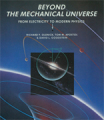
This second volume of the Mechanical Universe studies electricity and magnetism, their relation to each other and light, and shows how the problem of lightled to the special theory of relativity. Then, it moves on to modern physics,where particles may behave like waves and where some of the great verities ofNewtonian physics appear less certain. Along with the first volume, this bookis based on, though independent of, a public television series broadcast in the United States. Physics is presented as a human endeavor, with historical development forming a thread throughout the text. The prerequisites are minimal,only basic algebra and trigonometry since the necessary calculus is developedin the text, with physics providing the motivation. New concepts are introduced at the natural, logical point with many historical references to place physics in a social perspective. Many topics from twentieth-century physics are included. The book is attractively illustrated and will be a stimulating alternative to other, less-thorough treatments. INDICE: Preface; 31. Beyond the mechanical universe; 32. Static electricity; 33. The electric field; 34. Potential and capacitance; 35. Voltage, energy and force; 36. The electric battery; 37. Electric circuits; 38. Magnetism; 39.The magnetic field; 40. Vector fields and hydrodynamics; 41. Electromagnetic induction; 42. Alternating currents; 43. Maxwell’s equations; 44. Optics; 45. The Michelson-Morley experiment; 46. The Lorentz transformation; 47. Velocity and time; 48. Mass, momentum, energy; 49. Atoms; 50. Particles and waves; 51. Atoms to quarks; 52. The quantum mechanical universe; Appendix A. The international system of units; Appendix B. Conversion factors; Appendix C. The periodic table of the elements; Appendix D. Astronomical data; Appendix E. Physical constants; Index.
- ISBN: 978-0-521-71591-1
- Editorial: Cambridge University
- Encuadernacion: Rústica
- Páginas: 588
- Fecha Publicación: 01/03/2008
- Nº Volúmenes: 1
- Idioma: Inglés
